A hiring manager comes to you with an urgent request: they've found the perfect candidate for a critical role, but the salary expectation is 25% above your salary band because that role has become the hottest commodity on the talent market.
"Everyone else is paying this much," they say. "We'll lose them if we don't match it."
For Reward leaders, in-demand jobs are dangerous territory. The pressure to hire is intense, the stakes feel high, and the easiest path is throwing your compensation frameworks out the window and paying whatever it takes.
But that "exceptional" salary sets a new precedent. You can’t reduce the new hire’s salary when the market for their position slows down, which means you’re looking at sky-high payroll costs or compromised internal pay equity.
Gallagher’s Senior Reward Consultant Jenny Packer, and Reward Consultant Katie Cook, have both helped organisations navigate this exact challenge.
Their approach? Building a flexible structure that enables you to compete for in-demand jobs without compromising on your compensation philosophy.

Which jobs are in demand in 2025?
AI and Machine Learning skills are by far the most in-demand on the job market this year.
For our recent report on the tech job market in 2025, we surveyed Reward leaders across the tech industry, asking them which roles and skillsets their company was making a priority in hiring in 2025. 65% of respondents said that AI and Machine Learning is top of the list this year – the most in-demand skill by far.
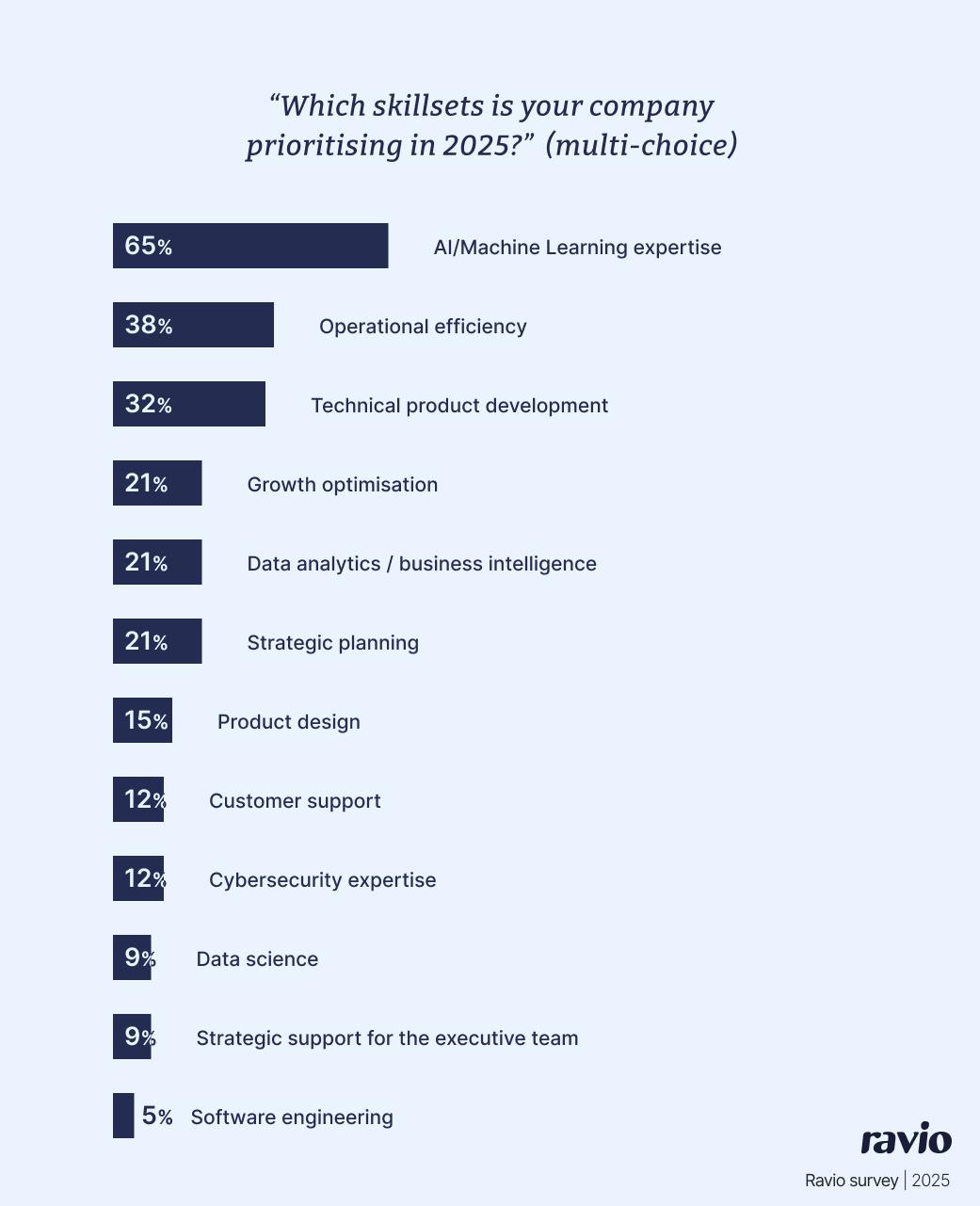
Looking at Ravio’s real-time compensation benchmarking data, we also identified that job titles containing ‘AI’ have surged by 578% in 2025 – growing from 0.32% of job titles in 2024 to 2.17% in just the first few months of 2025.
Given that two-thirds of companies are prioritising AI skills this year, we’d expect to see that continue to increase even further over the rest of the year.
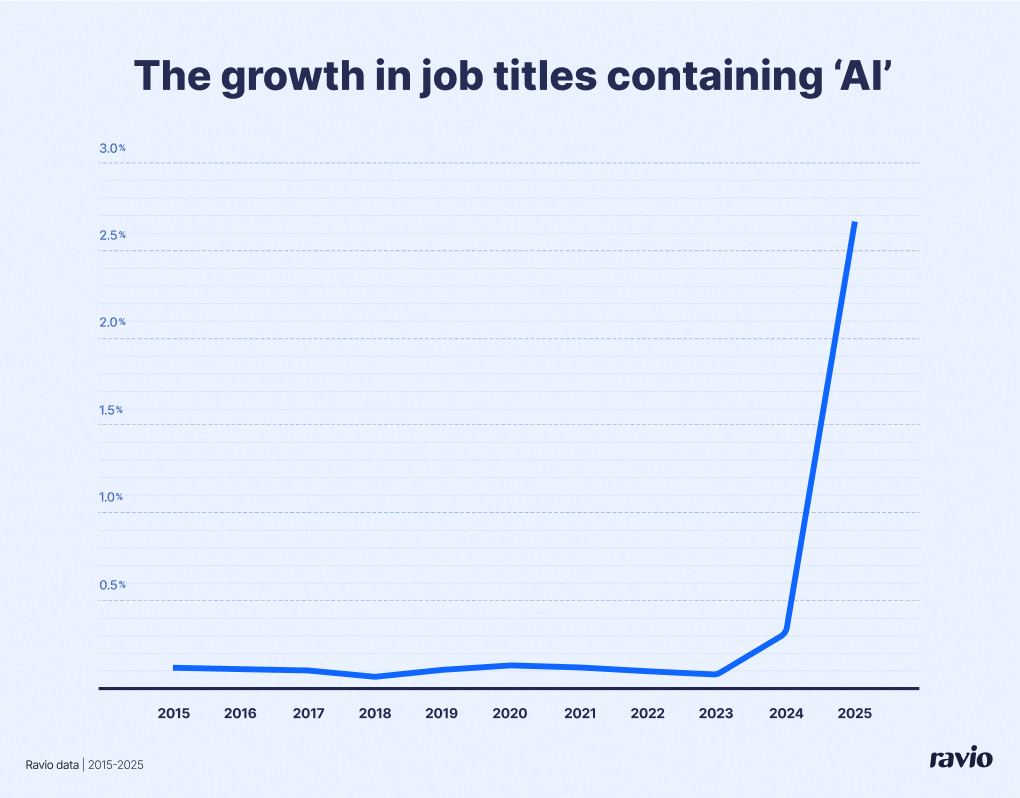
The most common AI job titles so far are AI Engineers and AI Researchers, but we’re also seeing AI-related job roles arise across all functions, such as AI Sales Prompt Engineers or AI Compliance Officer.
In fact, we can see from Ravio’s new hire benchmarks that AI Engineers are currently receiving 9.5% higher new hire salary offers than standard Software Engineer salaries – a premium that reflects how competitive the market has become for these new roles where there is a limited availability of talent.
💡The top 5 most common AI job titles in 2025
- AI Engineer
- AI Researcher
- Senior AI Engineer
- Senior AI Researcher
- AI Research Engineer
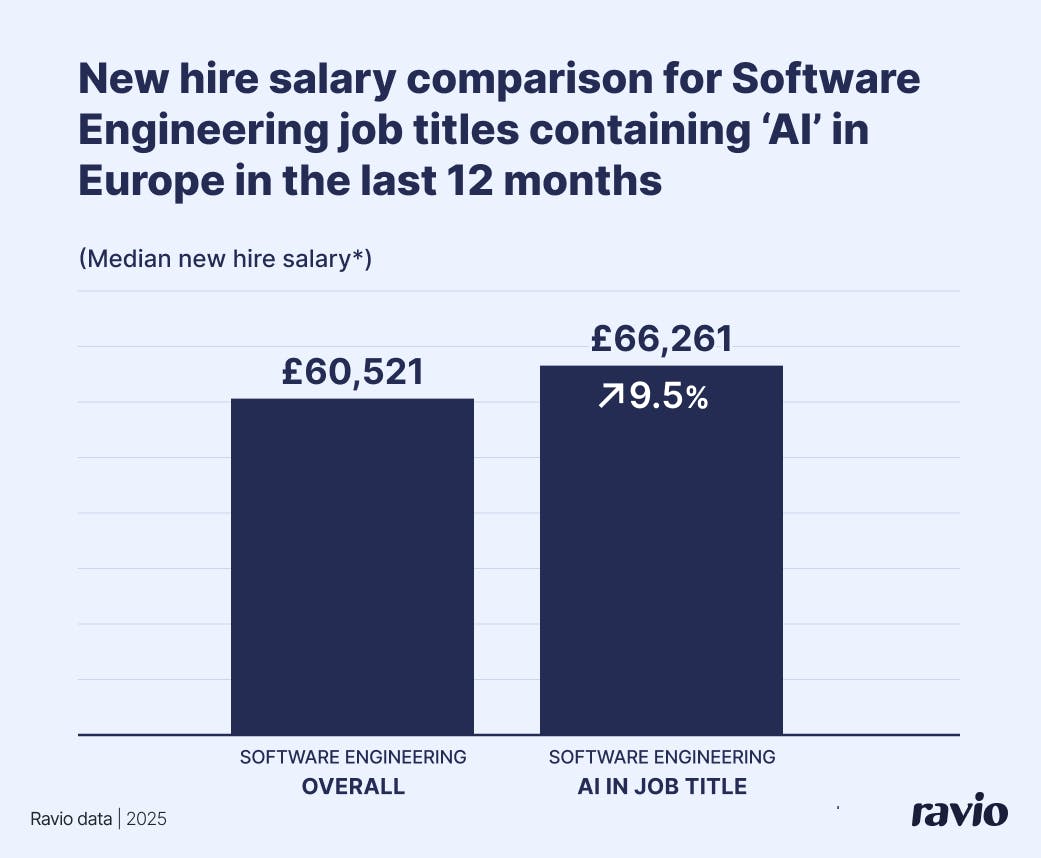
How to handle compensation for in demand jobs
When the pressure is on to secure talent for jobs that are in high demand on the talent market, there can be a temptation to abandon the compensation structures and principles that you’ve put so much effort into building and make reactive decisions to seal the deal – especially when you're seeing AI-first startups scale to huge heights with a very different hiring and compensation approach.
"There's a tendency for knee-jerk reactions,” explains Jenny Packer, Senior Reward Consultant, Gallagher.
“In my experience, with shifts in demand like we’re seeing for AI, the market almost always spikes and then settles down – that market premium doesn’t last forever, but the consequences of baking it into your payroll costs via a higher than desirable base salary do.”
The consequences are severe: salary band outliers that create long-term cost commitments, limited options for future career and pay progression for that new hire, and pay equity issues compared to existing colleagues. It’s a loss of consistency that can undermine your entire compensation structure.

"In my experience, with shifts in demand like we're seeing for AI, the market almost always spikes and then settles down . That market premium doesn't last forever, but the consequences of baking it into your payroll costs via a higher than desirable base salary do."

Senior Reward Consultant at Gallagher
The solution? Building flexibility into that overarching compensation structure, so that there’s a defined way to approach exceptions and trends whilst maintaining strategic focus and consistent decision-making.
Here’s a couple of examples of what that might look like.
Flexibility within the salary band structure
Designing a salary band structure which has a built-in mechanism for adapting to market trends for in-demand jobs, or other exceptions to your salary rules, means that you avoid needing to create new salary bands for in-demand jobs that are still in flux in the market.
“One approach is to overlay your salary band structure with competency or skill-based progression that influences how individuals are placed within each salary band,” explains Katie Cook, Reward Consultant, Gallagher.
“This way, if AI is an important skill for the organisation, and is also known to be in high demand on the talent market, then there’s a framework for placing the new hire in the upper quartile of their band.”
Another option is to have a mechanism for applying ‘market premiums’ to your existing salary bands – pre-defining an additional percentage that can be added onto the band range for business-critical roles whilst they are in high demand.
“Unlike permanent salary increases, the market premium approach offers a way to compete for talent in the short-term, without long-term cost commitments,” Katie explains. “It’s vital to review the changes made at least once a year so that they can be adjusted back as market conditions change.”
"One approach is to overlay your salary band structure with competency or skill-based progression... This way, there's a framework for placing the new hire in the upper quartile of their band."

Reward Consultant at Gallagher
Harnessing other elements of total compensation for flexibility
Rather than competing solely on base salary, build up other elements of the total compensation package to attract in-demand talent while keeping your salary structure intact.
"Organisations often focus on base pay only and not total compensation – bonuses, equity, benefits," highlights Jenny.
When you work with Gallagher’s reward consultants, they’ll always identify the key considerations unique to your organisation that influence what your total rewards should look like.
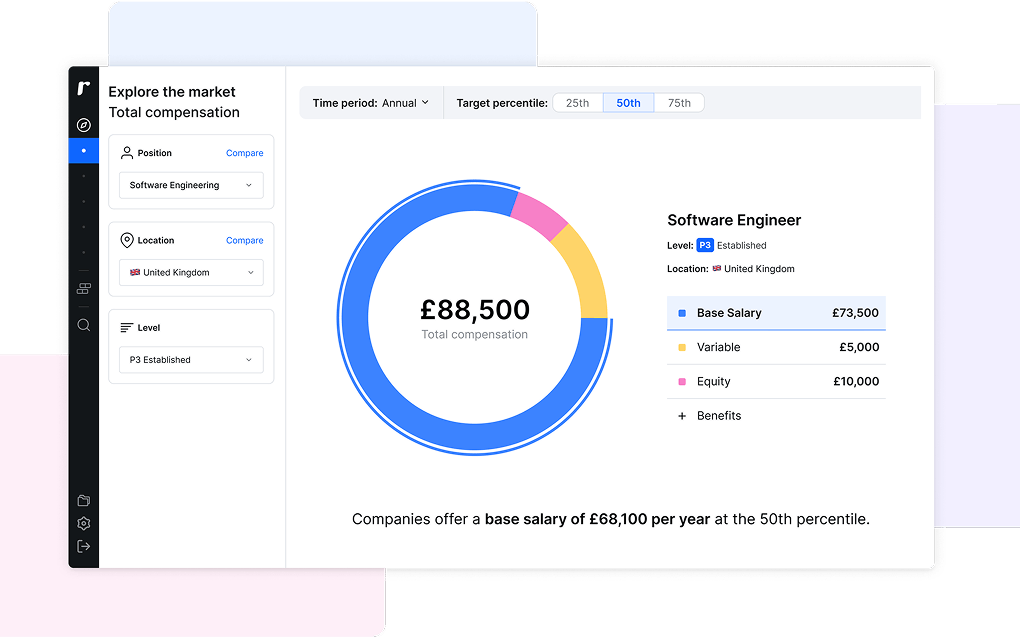
For instance, sign-on bonuses offer one effective approach. These can be structured as tax-free loans that are recovered if the individual leaves within a certain timeframe (another risk when hiring for jobs and skills that are in high demand), providing a way to compete on the market without permanent cost commitment.
Retention bonuses are also important to consider – especially given the average cost of replacing employees is typically at least £6,000 per hire (Chartered Institute of Personnel and Development), and much higher for senior or specialised roles.
In contrast, offering a competitive salary increase to a current employee not only avoids these upfront costs but also preserves institutional knowledge, strengthens team cohesion, and boosts engagement – factors that directly contribute to performance and retention. With labour market pressures continuing into 2025, investing in retention is not just a cultural win but a financial one.
"When you think about compensation for in-demand jobs, you instantly think of hiring external talent in a competitive market, but retaining existing talent who are seeing job adverts with salary ranges much higher than their own is equally (if not more) important."

Reward Consultant at Gallagher
“When you think about compensation for in-demand jobs, you instantly think of hiring external talent in a competitive market,” says Katie, “but retaining existing talent who are seeing job adverts with salary ranges much higher than their own is equally (if not more) important.”
“We worked with one client in the transport sector during a period of very high market demand for drivers,” Jenny recalls. “The introduction of retention bonuses meats that staff at risk of leaving are able to increase their take-home pay without moving elsewhere, and companies can avoid permanent salary increases that are hard to reverse later when the market shifts again.”
Employee benefits are another often overlooked lever to pull to secure, retain, and even grow talent for in-demand jobs.
“One example is investment in learning,” Katie says. “Maybe you could commit to certain training programmes or new AI accreditations that will help employees gain skills and progress their career and pay more quickly.”
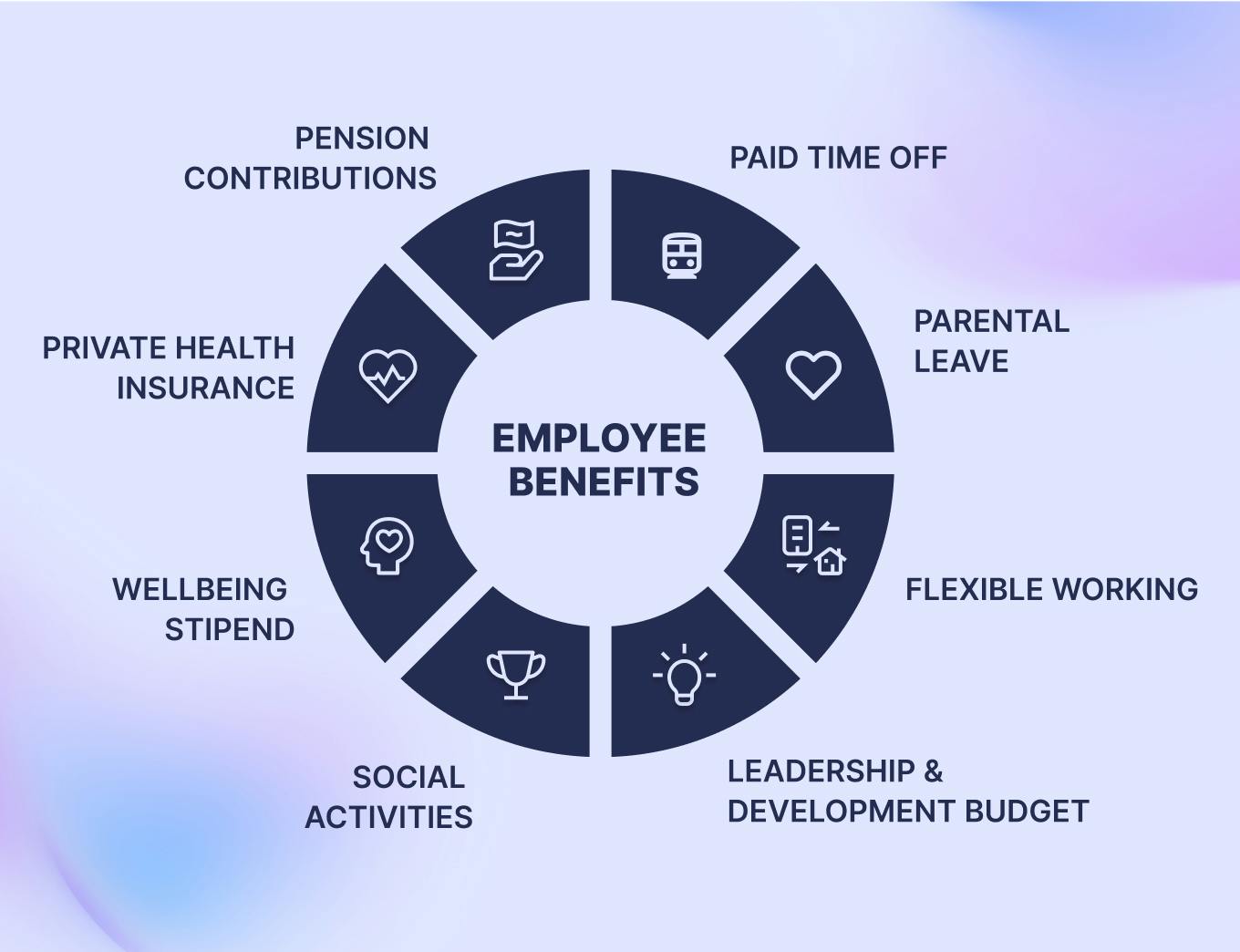
The key advantage of this approach is the ability to maintain the integrity of existing Reward structures, whilst providing competitive compensation packages to attract in-demand talent.
💡 Read more about employers' approaches to benefits in Gallagher’s 2024 UK Workforce Trends Report.
Build flexibility into pay structures to adapt to demand: Gallagher’s Discovery-Design-Delivery framework
So how do you build flexibility into your compensation framework? Having worked with a myriad of clients on exactly that, Gallagher has developed a clear three-stage process:
- Discovery: Audit your existing compensation structure
- Design: Build in adaptive mechanisms
- Delivery: Document policies
Discovery: Audit your existing compensation structure
The process begins with understanding how pay is currently set within the organisation – exploring questions like:
- How is pay currently determined for each role?
- What does the company want to reward?
- What salary benchmarking data sources are being used?
- Which companies are you competing with for talent?
- Are there any aspirational goals for pay e.g. paying everyone at least at the market median?
- Which job families or roles are seeing high attrition rates or difficulty with recruitment?
“The discovery phase enables you to identify where rigidity currently exists in the compensation system – whether it’s the structures themselves or the sign off and approval process,” Jenny explains. “That, coupled with identifying where talent is being lost, gives you the starting point for where flexibility is needed.”
Design: Build in adaptive mechanisms
With the discovery complete, it’s time to look at all the different options and determine what makes sense to align with those foundational philosophical principles about how the company wants to reward their employees.
As we saw earlier, this might include broad salary structures with multiple progression criteria, clear guidelines for when and how market premiums can be applied, variable compensation elements that can be scaled based on market conditions, or strong employee benefits propositions that align with what talent is looking for.
“Don’t forget about options for pay progression once individuals are in post too,” Jenny emphasises. “Regular reviews to check for market alignment against reliable data is a must – you need to know what’s in-demand in the market before your employees do. From there, we typically recommend some form of bonus structure (whether retention bonuses or performance bonuses) to enable that flexibility to retain existing employees.”
Katie also highlights the importance of reflecting on internal pay equity when these tactics are used: "Crucially, any flexible mechanisms must include provisions for ongoing pay equity monitoring to ensure exceptions don't inadvertently create systemic inequities."
Delivery: Document policies
The final step is to document the agreed approach – the core compensation structures that are in place, and the adaptive mechanisms that allow for flexibility.
“The aim is to provide clear messaging on how compensation decisions are made, including with market trends and exceptional circumstances,” explains Jenny. “That’s key for managing everyone’s expectations, from company leaders to hiring managers to employees.”
"Organisations, especially those within fast-paced markets, should work to build internal agility, shifting from a 'set and forget' mindset to one of continuous review."

Senior Reward Consultant at Gallagher
Compensation structures that flex with your needs
Talent markets always have, and will continue to, evolve rapidly.
The emergence of AI skills and roles like AI Engineering is just the latest example of this – there will be new emerging skills and in-demand jobs to come in the future.
The most successful approach combines strategic frameworks with tactical flexibility, enabling Reward teams to adapt to market shifts, without overreacting and abandoning their principles and frameworks.
As Jenny concludes: "Organisations, especially those within fast-paced markets, should work to build internal agility, shifting from a 'set and forget' mindset to one of continuous review."
Looking for further support on competing for in demand roles, without breaking your compensation philosophy? Get in touch with Gallagher’s reward consultants.



